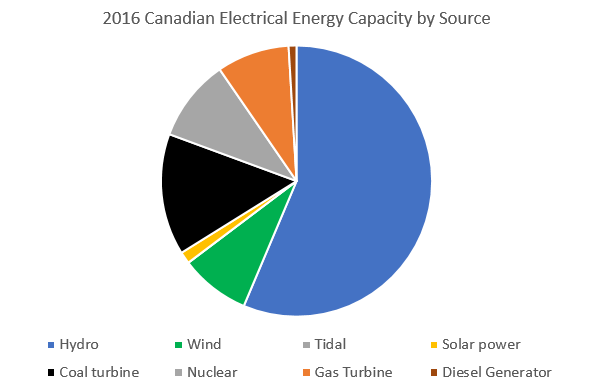Canadian Policy
Canadian energy markets varies widely compared to most other developed countries. For one of the largest countries in the world, it has the smallest population relative to land space. Unlike most countries, Canada has a very large natural hydro-electric capacity, mainly due to it's vast geological resources. Even though it's energy policy is very similar to that of those countries abiding within the EU policy, it's vastly different energy industry make it a interesting area of thought and discussion. It can be seen below in figure 1 the breakdown of Canada's electrical generation capacity by source.
Canada has an energy policy that has been framed and guided by a number of agreements and accords. As Canada is not part of the EU, energy is still a globally traded commodity, trade issues and emissions generated are subject to a number of international agreements and responsibilities.
Through the National Energy Board, Canadian Nuclear Safety Commission, the Atomic Energy of Canada Limited and the Program on Energy Research and Development, these departments support the development of energy technologies through both public and private funding. They are also used to help to promote and regulate the safety, security, environmental protection of Canada's energy infrastructure and market.
The Free Trade Agreement is a cornerstone of Canadian policy, closely followed by the North American Free Trade Agreement (NAFTA) which promotes free market conditions. By doing so this emphasizes the importance of competitive market behavior in the energy sector that allows and encourages the investment in Canadian energy markets. This is essential to a country like Canada where provinces such as North West Territories and Nunavut are very geologically isolated and still are very reliant on diesel generators. It is this reason if they do not continue to invest in other low-carbon options such as renewables and nuclear technology that they will remain to use internal combustion engines as a means to generate electricity.
Through the National Energy Board, Canadian Nuclear Safety Commission, the Atomic Energy of Canada Limited and the Program on Energy Research and Development, these departments support the development of energy technologies through both public and private funding. They are also used to help to promote and regulate the safety, security, environmental protection of Canada's energy infrastructure and market.
The Free Trade Agreement is a cornerstone of Canadian policy, closely followed by the North American Free Trade Agreement (NAFTA) which promotes free market conditions. By doing so this emphasizes the importance of competitive market behavior in the energy sector that allows and encourages the investment in Canadian energy markets. This is essential to a country like Canada where provinces such as North West Territories and Nunavut are very geologically isolated and still are very reliant on diesel generators. It is this reason if they do not continue to invest in other low-carbon options such as renewables and nuclear technology that they will remain to use internal combustion engines as a means to generate electricity.
EV policy and targets
Ontario, Quebec and British Columbia are the only provinces within Canada's who's local Governments have finicial incentives to promote and encourage sales and leasing of EVs. Ontario is set to achieve its climate change goal of reducing greenhouse gas emissions (GHG) to 15% below 1990 levels in 2020, 37% in 2030 and 80% in 2050 only by switching over to EVs from standard combustion engines
The Electric and Hydrogen Vehicle Incentive Program (EHVIP) supports the adoption of electric vehicles (EVs) and hydrogen fuel cell vehicles (HFCVs) by providing incentives for the purchase and/or lease of eligible EVs and HFCVs.
On March 9, 2018, the Electric Vehicle Incentive Program (EVIP) became the Electric and Hydrogen Vehicle Incentive Program, with the following changes:
The Electric and Hydrogen Vehicle Incentive Program (EHVIP) supports the adoption of electric vehicles (EVs) and hydrogen fuel cell vehicles (HFCVs) by providing incentives for the purchase and/or lease of eligible EVs and HFCVs.
On March 9, 2018, the Electric Vehicle Incentive Program (EVIP) became the Electric and Hydrogen Vehicle Incentive Program, with the following changes:
- Incentives of up to $14,000 will be provided for eligible hydrogen fuel cell vehicles (HFCVs);
- Incentives for eligible battery electric vehicles (BEVs) and plug-in hybrid electric vehicles (PHEVs) are now determined based on each vehicle’s all-electric range and seating capacity. The updated incentives vary from $5,000 to $14,000;
- Incentives will no longer be provided for PHEVs or BEVs with a Manufacturer’s Suggested Retail Price (MSRP) of $75,000 or more; and
- Incentives will no longer be provided for PHEVs or BEVs leased for less than three years.



